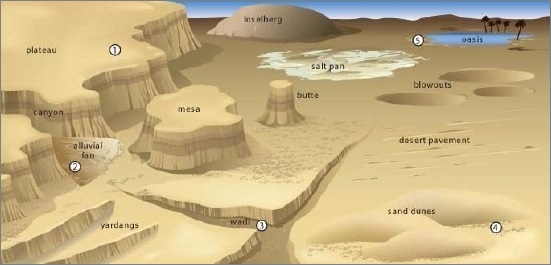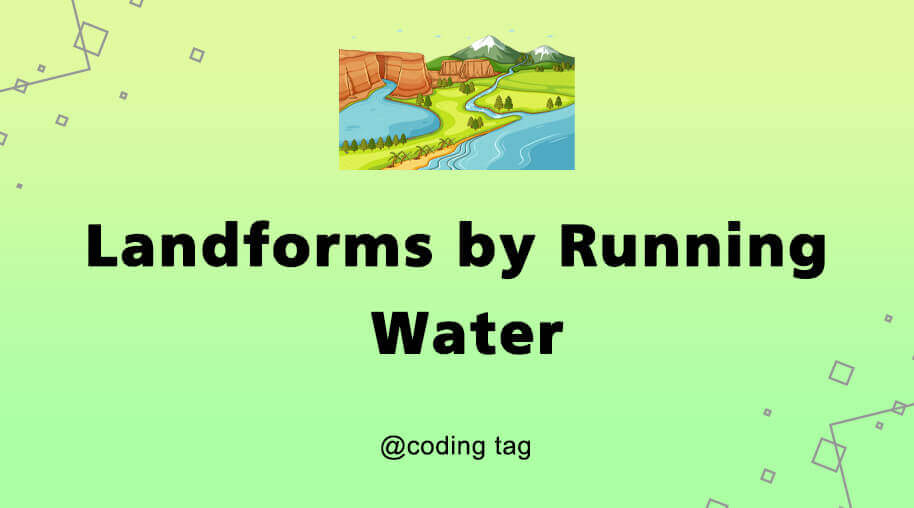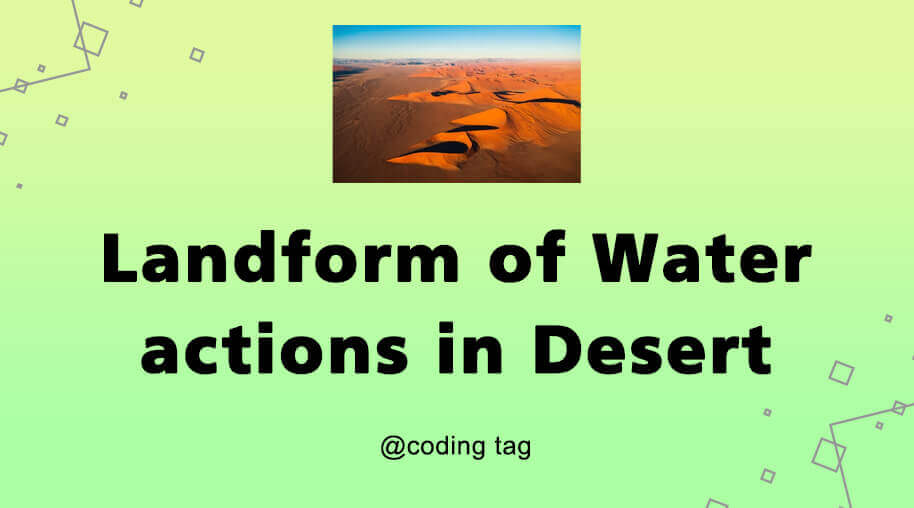Desert Landforms and Erosion Mechanism
by Devender
0 3190
Deserts make around 1/5th of the world's land. True deserts are those deserts where nothing grows and are absolutely barren.
Desert Landforms & erosion mechanism
- Deserts
- These deserts lie in the trade wind belt on the western parts of the continents
- The offshore trade winds are often bathed in cold currents that produce a dehydrating effect
- Therefore, moisture is not easily condensed into precipitation
- Canyon
- Butte
- Oasis
- Yardang
- Alluvial Fan
- Inselberg
- Blowouts
- Zeugen
- Mesa
- Salt Pan
- Sand Dunes
- Mushroom Rocks
- It consists of large stretches of bare rocks
- It is swept clear of sand and dust by wind
- Its exposed rocks are thoroughly smoothened, polished and highly sterile
- Stony deserts are more accessible than sandy deserts
- Large herds of camels are kept there
- These are also known as seas of sand
- Vast stretches of undulating sand dunes are deposited there by winds in their direction
- It is not fit for agriculture or survival
- The entire region is abandoned by its inhabitants
- Due to the action of frost, their steep slopes consist of Wadis (dry valleys) with sharp and irregular edges
- Successive freezing will prise of fragments of rocks which get accumulated as screes
- As heat penetrates rock, its outer surface gets heated & expands, leaving its inner surface comparatively cool
- Therefore, the outer surface prise itself from the inner surface & peels off in successive thin layers, known as exfoliation
- Deflation
- Finer dust and sands may be removed miles away from their place of origin and may get deposited even outside the desert margins
- Deflation results in the lowering of the land surface to form large depressions called Deflation hollows
- Abrasion
- Abrasion is most effective near the base of the rocks, where the amount of material the wind is able to carry is greatest
- This explains why telegraphic poles in the deserts are protected by covering metal for a foot or two above the ground
- Attrition
The main causes of desert's aridity are insufficient & irregular rainfall, high temperature & rapid rate of evaporation. Almost all the deserts are confined within 15 – 30 Degree parallels to N – S of the equator known as trade wind deserts or tropical deserts.
Deserts Landforms

These are the different types of landforms in a desert:
Types of deserts
1 Hamada/Rocky Desert
2 Reg/Stony Desert
It is composed of extensive sheets of angular pebbles and gravels which the wind is not able to blow off.
3 Erg/Sandy Desert
4 Badlands
It consists of gully & ravines formed on hill slopes and rock surfaces by the extent of water action.
5 Mountain Deserts
These deserts are found on the highlands such as on plateaus & mountain ranges, where erosion has dissected the desert highland into rough chaotic peaks & uneven ranges.
Mechanism of Desert/Arid Erosion
1 Weathering
It is the most potent factor in reducing rocks to sand in arid regions. Although, deserts receive minimal rain but still, manage to penetrate into rocks and start chemical reactions in them.
The rocks get weakened and when it faces intense heating during the day and rapid cooling during the night by radiations, it set up stresses in the rock. Hence, it breaks. When water gets into the cracks of a rock, it freezes at night and expands by 10% of its volume.
2 Action of Wind
It is very efficient in arid regions because of very little vegetation or moisture to bind the loose surface materials. It is carried out in the following ways:
It involves lifting & blowing away loose materials from the ground. The blowing capacity depends upon the size of the material lifted from the surface.
The sandblasting of rock surfaces by the wind when they hurl sand particles against them. This results in rock surfaces being scratched, polished and worn away.
When wind-borne particles roll against one another in a collision, they wear each other away. Hence, their sizes are greatly reduced and grains are rounded into millet seed sand.

Share:







Comments
Waiting for your comments